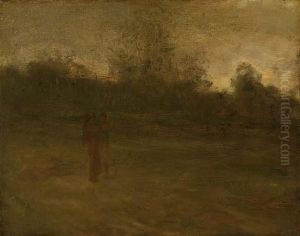George Fuller Paintings
George Fuller was an American artist known for his unique approach to painting, characterized by a poetic and often moody visualization of rural American life and landscape. Born in Deerfield, Massachusetts, on January 17, 1822, he grew up in a farming family and developed an early interest in art. Despite the agricultural lifestyle of his family, Fuller pursued his passion for art, although his career progressed slowly.
Fuller began his formal art education in Boston and subsequently traveled to Europe in the 1850s to further study the Old Masters. During his time abroad, he was particularly influenced by the Barbizon School, a group of French artists who emphasized naturalism and mood in landscape painting. This influence would later become evident in his own works.
Returning to the United States in the late 1850s, Fuller became involved in running the family farm due to financial hardships. For nearly a decade, he painted very little as his time and energy were consumed by farming duties. However, during this period, he continued to develop his artistic vision, which would later culminate in a distinctive style that combined realism with a dreamy, ethereal quality.
It was not until the 1870s that Fuller returned to painting full-time, and it was during this decade that he produced the works that would define his legacy. His paintings often depicted the American countryside and its inhabitants, suffused with a sense of melancholy and transcendence. Fuller's use of light and shadow, as well as his soft focus technique, gave his paintings an almost mystical quality.
Some of Fuller's most notable works include 'The Quadroon', 'Nydia', and 'The Evangeline'. His paintings were well received, and he was recognized by contemporaries as a significant American artist. Fuller was a member of the National Academy of Design and his work was exhibited at various prestigious institutions during his lifetime.
George Fuller's career was relatively short, and he died on March 21, 1884, in Brookline, Massachusetts. Despite his brief period of artistic production, Fuller made a lasting impact on American art, particularly as a forerunner of the Tonalist movement, which emerged at the close of the 19th century and featured subdued color palettes and an emphasis on mood and atmosphere in painting. His work is now held in numerous museum collections, including the Metropolitan Museum of Art, and continues to be celebrated for its emotional depth and beauty.




















